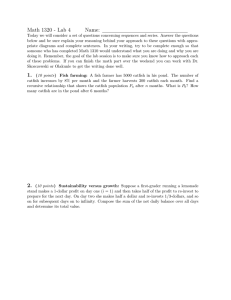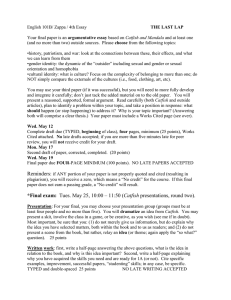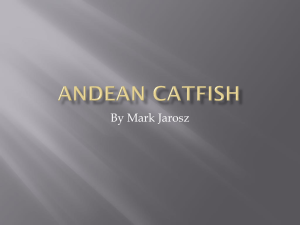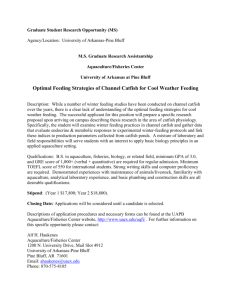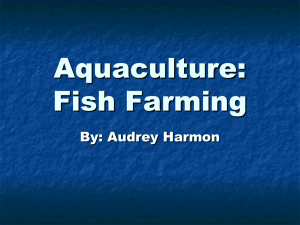African Catfish Farmers` Perception on Climate Change and Contribution of... Production to Household Income in Lagos State, Nigeria.
advertisement
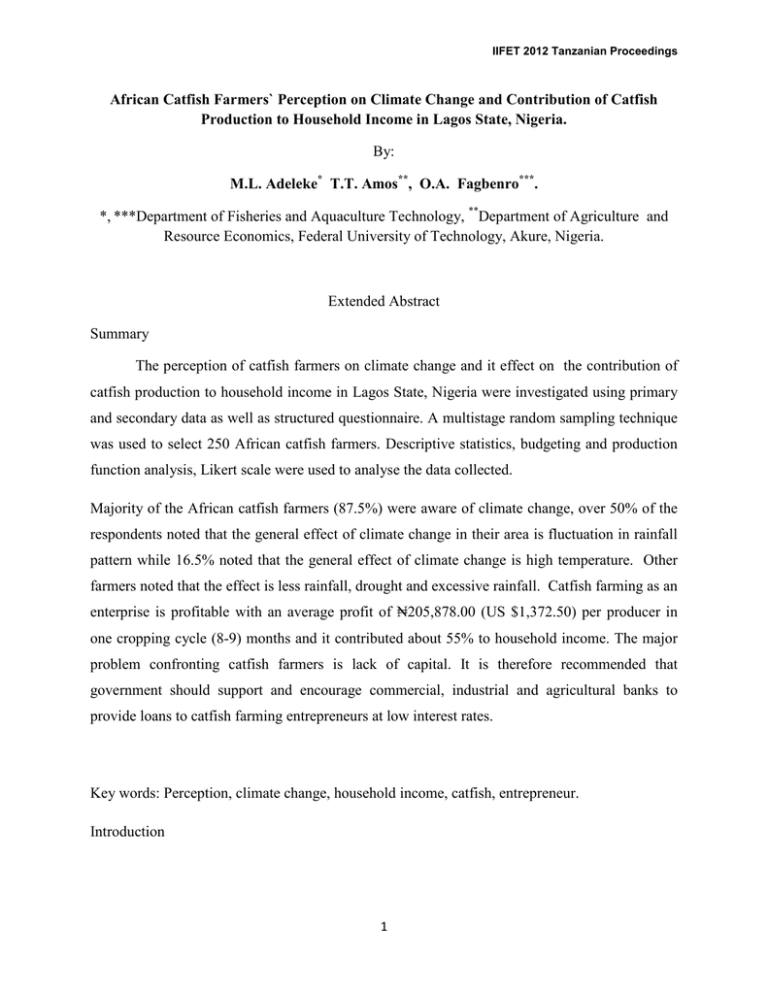
IIFET 2012 Tanzanian Proceedings African Catfish Farmers` Perception on Climate Change and Contribution of Catfish Production to Household Income in Lagos State, Nigeria. By: M.L. Adeleke* T.T. Amos**, O.A. Fagbenro***. *, ***Department of Fisheries and Aquaculture Technology, **Department of Agriculture and Resource Economics, Federal University of Technology, Akure, Nigeria. Extended Abstract Summary The perception of catfish farmers on climate change and it effect on the contribution of catfish production to household income in Lagos State, Nigeria were investigated using primary and secondary data as well as structured questionnaire. A multistage random sampling technique was used to select 250 African catfish farmers. Descriptive statistics, budgeting and production function analysis, Likert scale were used to analyse the data collected. Majority of the African catfish farmers (87.5%) were aware of climate change, over 50% of the respondents noted that the general effect of climate change in their area is fluctuation in rainfall pattern while 16.5% noted that the general effect of climate change is high temperature. Other farmers noted that the effect is less rainfall, drought and excessive rainfall. Catfish farming as an enterprise is profitable with an average profit of ₦205,878.00 (US $1,372.50) per producer in one cropping cycle (8-9) months and it contributed about 55% to household income. The major problem confronting catfish farmers is lack of capital. It is therefore recommended that government should support and encourage commercial, industrial and agricultural banks to provide loans to catfish farming entrepreneurs at low interest rates. Key words: Perception, climate change, household income, catfish, entrepreneur. Introduction 1 IIFET 2012 Tanzanian Proceedings Fish is a major source of animal protein and an essential food item in the diet of many Nigerians, being relatively cheaper than meat. Much of the fish consumed consists of cheap species such as Sardinella, Bonga, Moonfish, Ilisha, catfish and Tilalpia, especially in the coastal and inland rural areas where incomes are generally low (Tobor 1990). Fisheries represent an important part of the world’s economy. In Nigeria, like other parts of the world, inland and coastal fisheries and related fish processing and trading provide full or part time employment for between 6 and 9 million people in African, Nigeria inclusive (CBN, 2004) Many fish farms focus on catfish, as they can have a market value of two to three times that of tilapia (F.A.O 2005). Catfishes of the family Claridae comprise the most commonly cultivated fishes in Nigeria. The growth of aquaculture in Nigeria now is largely being boosted by a steady rise in catfish culture. Since the culture of Clarias gariepinus through hypophysation was initiated in Western Nigeria in 1973, the procedure has been widely practiced throughout Nigeria thus leading to increase of farm-raised catfishes from the 80’s to date. The favoured catfish species in Nigeria aquaculture include: Clarias gariepinus, Heterobranchus bidorsalis, Clarias X Heterobranchus hybrid (Heteroclarias) and Clarias nigrodigitatus. Heterobranchus sp is the more commonly cultured fish in the South Eastern parts of Nigeria. Statistics indicate that Nigeria is the largest African aquaculture producer, with production output of over 15,489 tonnes per annum, which constitutes about 4% of the nation’s agricultural G.D.P. (F.A.O 2005). This work assess the perception of catfish farmers on climate change and estimate the contribution of catfish production to household income in Lagos State, Nigeria. Specifically the objectives also describe the socio-economic characteristics of catfish farmers in Lagos State, examine the factors that affect catfish production, estimate the cost and returns relationship involved in catfish farming, and identify the major constraints facing fish farming in Lagos State. Materials and Methods The study was conducted in Lagos State, Nigeria. Lagos State stretches for about 180 km. along the coast of the Atlantic Ocean. It therefore has 22.5% of Nigeria's coastline and occupies an area of about 3,577 square kilometres landmass with about 786.94 square kilometres, (22%) 2 IIFET 2012 Tanzanian Proceedings of it being lagoons and creeks. Although, the state is endowed with 147,877 hectares of swampland and large areas of water bodies suitable for aquaculture to feed its ever increasing human population of over 10 million people, only 61.28 hectares (about 0.04%) is used for aquaculture (Lagos State Fisheries Department, 1998). Sampling Technique and Sample Size Data were collected from Fish farmers in five (5) Local Government Areas (LGAs) which were purposively selected based on the fact that they have a concentration of fish farming communities in the State. They are: Ikorodu, Epe, Ibeju-Lekki, Alimosho-Ikeja and Eti-Osa LGAs. From each LGA, 50 fish farms were selected randomly. The list of fish farmers was obtained from the ADP office and used for the selection process. Thus a total of Two hundred and fifty catfish farmers (respondents) were used for this study. Data were collected using a wellstructured questionnaire administered on the respondents. Analytical Techniques The Analytical tools used in the study are: (a) The descriptive Statistics such as frequency distribution, mean, standard deviation and percentages. These were used to describe the socio-economic variables of the catfish farmers such as age, years of experience, household size and marital status and fish related information, such as pond size, stocking rate and volume of catch. (b)Budgeting Analysis, which involves the use of Net Farm Income was used to estimate the contribution of catfish production to household income. Net Farm Income (NFI) was specified as: NFI= TR – TC ………………………………..1 TC= TFC + TVC ………………………………2 TR= PQ ………………………………………….3 NFI=TR – (TVC+TFC) ……………………….4 3 IIFET 2012 Tanzanian Proceedings TFC= Total Fixed Cost TVC= Total Variable Cost, TC= Total Cost NFI/Kg of Catfish = ……………………….5 NFI/Naira Invested = ……………………..6 NFI = Net Farm Income, TR= Total Revenue P = Price of catfish to be sold Q = Quantity of catfish produced (c) The production function analysis which involved the use of the regression model was used to examine the relationship between the dependent variable (output) and a set of independent variables. The implicit form of the regression model specified is presented by the equation: Y= f(X1,X2,X3,X4,X5,X6, U)………………………….................... (7) The explicit linear function in linear format is presented by equation: Y=b0+b1X1+b2X2+b3X3+b4X4+b5X5+b6X6……………………………………(8) Where: Y= dependent variable X’s= independent variables b’s= regression coefficients to be estimated and, U= error term Y=quantity of catfish harvested (kg) X1= Age of Respondents X2= Present Capital X3= Stocking Rate X4= Cost of feeding X5= Source of Water X6= years of experience U= error term 4 IIFET 2012 Tanzanian Proceedings The double logarithmic of the regression model is presented as specified by: Log=b0+b1X1+b2logX2+b3logX3+b4logX4+b5logX5+b6logX6 A five scaled likert was used to determine the perception of the fish farmers on climate change. References Akintola, S. L. Kumolu-Johnson, C.A. Fakoya, K.A and Asamu, S.O. ( 2009) Developments and Growth in the Aquaculture Industry in Nigeria. African Journal of Management and Development 4 : 21-25. Fish for all Summit (2005): Presentation of Nigeria’s Fisheries resources Abuja, Nigeria 22 – 25 August 2005. Tobor J G (1995): An appraisal of fisheries development efforts in Nigeria. Fish. Soc. Nigeria Conf. Proc. pp: 78. 5
